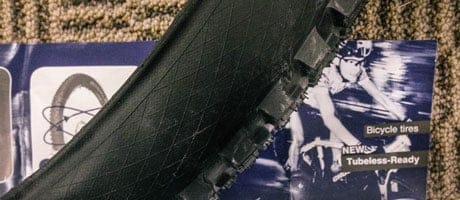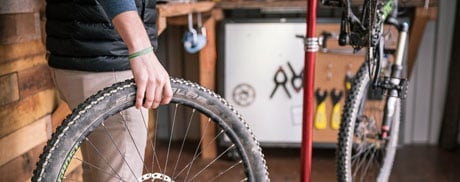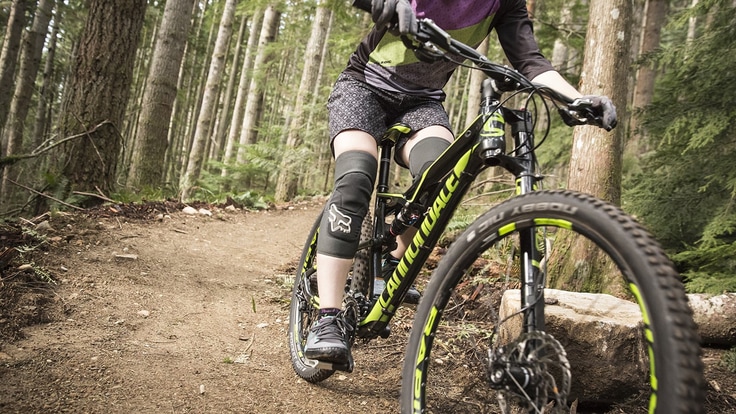Once wielded solely by elite racers, tubeless tires are gaining popularity with more and more riders these days. Car tires made the evolution to tubeless eons ago, so it's not surprising to see the same shift happening in the bike world.
In order to have a tire without a tube, you need the tire's bead to lock onto the rim. You also need the tire, rim and seated valve stem to be absolutely airtight. A special sealant is key to making it all work.
If you've been thinking it might be time to go tubeless, this article can help.
Learn about other factors to consider when you upgrade your tires by checking out our Mountain Bike Tires: How to Choose article.
If you have a road bike, you can also find tubeless options, though the trend there lags behind what's happening in mountain biking.
Shop REI's selection of tubeless-ready tires and wheels.
Pros and Cons for Going Tubeless
Pros:
You'll Get Fewer Flats: A tire deforms when you hit a hard object like a rock. With a big impact and a tubed tire, that rock and your rim can squeeze together forcefully enough to tear a tube. Whether you call it a "pinch flat" or a "snake bite" (a pair of pinch holes), you've got a flat to fix. Switch to tubeless tires and you'll never have to fix a pinch flat again.
Also, thanks to the sealant put in during mounting, tubeless tires suffer far fewer puncture flats. Tubeless riders who discover a tire riddled with shiny spots after a ride can smile knowing that their sealant fixed all those thorn pricks on the fly.
You'll Get a Better Ride: Many riders report that eliminating the tube gives them a better feel for the trail. In addition, tubeless tires can be ridden at a much lower pressure than tubed tires (no pinch flats to worry about), which puts more tire tread in contact with the ground. The result is better traction, especially in corners.
Running at a low PSI helps maintain your bike's momentum, too, because tires are able to conform to obstacles, rather than bounce off of them. That also allows a tire to absorb small bumps and trail chatter, giving you a smoother ride.
You'll Save Some Weight: The weight you save by switching is hard to quantify because of the variety of ways to go tubeless. For starters, eliminating a standard tube can save up to 200 grams. All tubeless wheels and tires have an inflation valve and sealant inside, which offsets that weight savings, but the net result is almost always fewer grams overall.
The upside to even minimal weight savings is that it's in a rotational component. That translates to less energy expenditure as you ride, so your legs will feel fresher.
Cons:
You'll Spend More Money: Tubeless-ready tires and wheels do indeed cost more. But you also generally get more value for your money. Most brands' most-advanced offerings are tubeless ready, so when you shop for tubeless components you're likely to see tires with advanced rubber compounds and wheels that are strong and light.
They Take Longer to Mount: Installing tubeless tires can be a little tricky. The biggest challenge is getting the tire bead to seat on the rim correctly—the seal has to be airtight. The process requires you to carefully add sealant, then a lot of air in a hurry.
You'll Still Have to Carry a Tube: If you do flat on a ride, it means the breach was too big for sealant to self-repair, so the fix is to put a tube in your tire. Thus, you always need to carry along an emergency tube.
You'll Have to Mess with Sealant: Adding sealant to achieve an airtight seal between tire and rim is an inherently messy process. And on the rare occasion that a tire gets gashed enough to splatter components and clothing, cleaning off that sealant isn't a lot of fun.
You also need to add tire sealant periodically after it has dissipated or dried out. This might be every few months in warm climates or once a year if you live in a cool, wet part of the country.
Ways to Go Tubeless

Option 1: Get Tubeless-Ready Wheels and Tires
Look for a tubeless designation like "UST" (Universal System Tubeless), the original standard. You'll also see similar, though different, terminology like "tubeless ready" or "tubeless compatible" from some brands.
UST-designated rims and tires are considered slightly easier to mount, in part because of how well the tire bead locks onto the rim. They typically require less sealant, too, because they are inherently more airtight. UST components are a little heavier, though, which is one reason why alternative tubeless-compatible systems are gaining popularity.
Your current wheels or tires might already be tubeless ready, so double-check before assuming that they're not. Some top-end bikes come with tubeless-ready tires and rims, though they might have been shipped with tubes in their tires to simplify showroom setup.
Getting new rims and tires is the most expensive way to upgrade, but it also offers the easiest installation and the most reliable bead-to-rim seal. You'll need sealant and perhaps some valve stems to do the installation, but that should be the extent of your additional expenses.
Option 2: Convert Your Current Tires and Wheels to Run Tubeless
Almost any combination of wheels and tires can be transformed using a tubeless conversion kit. The setup ranges from simple to challenging, because air can find more places to leak in non-tubeless-ready components.
Conversion kits cost about $70, though you can cut that cost by purchasing components individually. At a minimum, you need sealant, rim tape and a valve.
Tips for Mounting Tubeless Tires

- Go easy on the tire levers. Levers, especially metal ones, can kink the bead, creating a leak. If you use them, do so gently and sparingly. For help coaxing the tire bead over the rim, try using a solution of soapy water.
- An air compressor is a huge help. This solves the problem of inflating the tire rapidly enough to quickly seat the bead onto the rim. You can also use a C02 cartridge, but that can get expensive if you do multiple inflations.
- Removing the valve core can also help. Doing this initially helps you fill the tire more rapidly in order to fully seat the tire bead onto the rim. After it's seated, you can replace the valve core and inflate the tire to the desired PSI.
- Inserting a tube can help. If a tire's bead isn't seating well, try inserting a tube. Then leave it inflated inside the tire overnight to help reestablish the tire's original shape.
If you can change a tire and you can follow directions, you can do this. Don't despair if you have setbacks, because even veteran bike mechanics encounter uncooperative tires. And you always have the option of taking your tire and wheel to an REI bike shop to have them do the deed for you.



